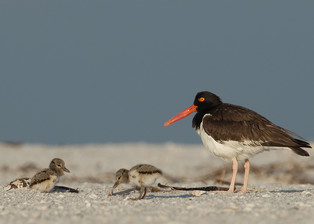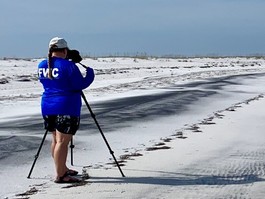
The 2020 FSA Monitoring Data at Work Annual Report is Here!
The 2020 “Florida Shorebird Alliance Monitoring Data at Work” annual report is hot off the presses and on the FSA website. Led by FWRI’s shorebird data team, the annual report presents monitoring data from 2011-2019 and summarizes how FSA monitoring data is used to measure progress toward conservation goals, identify information gaps, and adaptively manage for the long-term recovery of shorebird and seabird populations. This year, the data team is especially excited to present abundance estimates for black skimmers and least terns!
The 2020 report features:
- Summaries of monitoring and posting efforts
- Abundance estimates for black skimmers and least terns
- An update on filling a data gap on the Wilson's plover
- Details of the impacts of Hurricane Michael on snowy plovers in the panhandle
- Updated priority species fact sheets
THANK YOU to all of the shorebird monitors, stewards, and FSA partners. This report is a reflection of your hard work and dedication, and we are thankful to be your partner in shorebird conservation! Please email us with any questions.
Report cover photo: Britt Brown
|

Be a 4th of July Beach Hero!
As people make plans to go to the beach for the Independence Day holiday, the FWC is reminding the public to help protect beach-nesting shorebirds by giving them space and keeping personal fireworks off the beach.
Shorebirds on Florida’s Atlantic and Gulf coasts are nesting now, with many of them watching over flightless chicks. Threatened species such as the snowy plover, least tern, black skimmer and American oystercatcher are among the shorebirds facing conservation challenges and needing help from people to survive. Loud noises can cause adults to flush off their nests and tiny chicks to become separated from parents, leaving them vulnerable to predators, the elements, and getting stepped on by beachgoers.
Be a 4th of July Beach Hero:
- Leave personal fireworks at home. The loud sounds and bright lights of impromptu fireworks on Florida's beaches and waterways can have catastrophic effects on nesting birds and their chicks, as well as nesting sea turtles.
- Do not enter posted areas, including Critical Wildlife Areas, and keep your distance from nesting shorebirds and sea turtles.
- Leave Fido at home. If you walk your dog on a pet-friendly beach, keep it on a leash and at a distance from birds, sea turtles, and their nests.
- Do not feed birds and properly discard of trash, picnic leftovers and fish scraps. These scraps attract predators that will eat the eggs and hatchlings of birds and sea turtles.
- Boaters can help protect nesting birds by not getting close to or making loud noises near Critical Wildlife Areas.
Have a safe 4th of July and remember to share the shore!
Photo: Mia McPherson
|


You Spent 13,480 Hours Monitoring in 2019!
FSA partners spent over 13,480 hours monitoring nesting sites in 2019. That’s equivalent to 561 full days (or 1.5 years) of monitoring in an 8-month period! That doesn’t even include the time partners spent traveling to and from nesting locations, entering data into the FSD, or participating in stewarding and outreach efforts. The feat of monitoring Florida’s shorebird and seabird populations statewide is possible because of FSA partners!
Want to know more about what FSA partners did in 2019? Click here for this year’s Florida Shorebird Alliance Monitoring Data at Work report!
Photo: Britt Brown
|
|